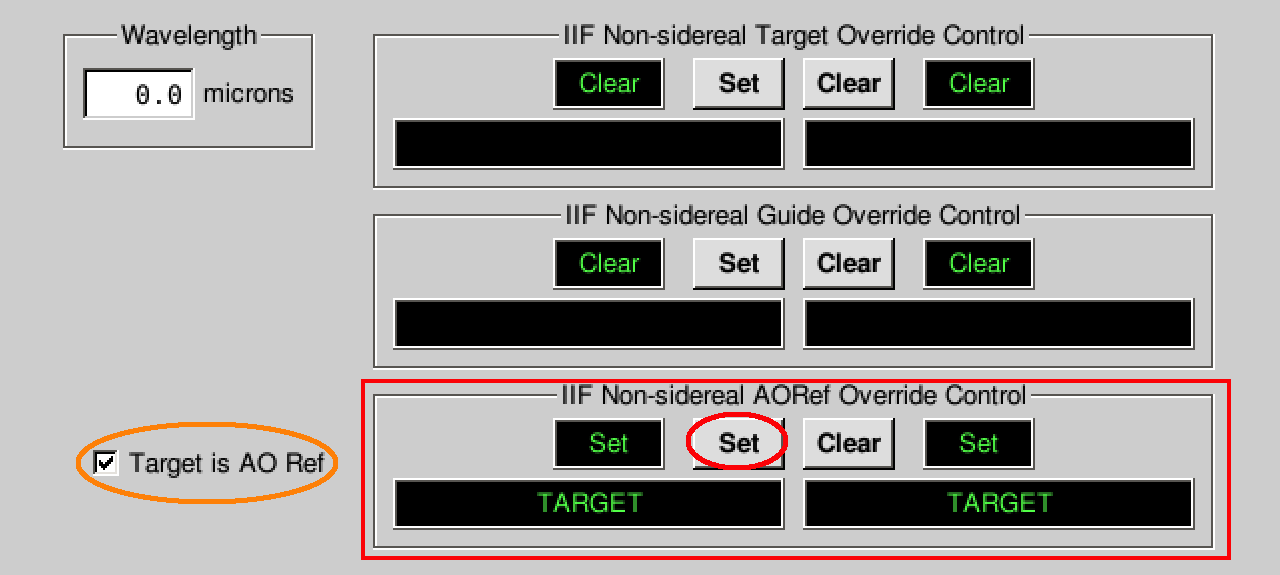Non-Sidereal Operations
Non-Sidereal Rates can be obtained from the JPL Horizon’s website. The tool used to track/guide non sidereally is the NSIGUI. This tool “hijacks” the preset applying the appropriate telescope tracking rates and coordinates when a preset is sent. There are 3 types of non-sidereal “hijacking” with the NSIGUI:
- Target Override
- Guide Override
- AORef Override
How to implement the common Non-sidereal hijack modes is described below.
Non Sidereal Execution
- Bring up the NSIGUI on an obs machine by typing NSIGUI
- Obtain the Ephemeris File for the target.
- In the NSIGUI enter a JPL Horizon’s identifier for the Target Name.

- Click “Get Ephemeris”. This will generate an Ephemeris File for the target located in /lbt/ephemeris/. This query should be entered after 17:00MST (0:00UT) to generate an Ephemeris file for the current night.
- Confirm the query was successful in the message log at the bottom of the NSIGUI.
- In the NSIGUI enter a JPL Horizon’s identifier for the Target Name.
- Set the appropriate IIF Non-Sidereal Override Control immediately before preset (before sending your script).
- For seeing-limited, non-sidereal targets: Set the IIF Non-Sidereal Target Override Control. The fields in the Target Override Control will populate with the name of the Ephemeris file.
Active presets (like those typically sent for the Gregorian instruments) will use the guide stars supplied in the scripts. The user will need to ensure they remain in the patrol field during the entirety of the observation as the telescope tracks the non-sidereal target.
- For AO observations (LBTI or LUCI AO), the Target can double as the AO ref star allowing for non-sidereal AO. To set a non-sidereal target as an AO ref, Select the Set button of the IIF Non-Sidereal Target Override Control. Select the “Target is AO ref” radio button. Select the Set IIF Non-Sidereal AORef Override Control. The fields in the AORef Override Control will populate with the word TARGET.
- For seeing-limited, non-sidereal targets: Set the IIF Non-Sidereal Target Override Control. The fields in the Target Override Control will populate with the name of the Ephemeris file.
- Play OBs/scripts to send presets and configure instrument. For Prime focus, the OB will send a TRACK preset. For Seeing Limited obs at Gregorian focal stations, the script will send ACTIVE presets. The telescope will slew setting the Target/Guide/AOref (depending of the IIF Override mode selected) coordinates provided in the Ephemeris file uploaded and track according to those rates.
Confirmation
Some sanity checks you can do after you have submitted your script:
- FACSUM should say “Non-sidereal”
- The RA/Dec of the telescope (shown in FACSUM) should be near the value found for that minute in the ephemeris file.
- Rates can be confirmed in the PCSGUI =>SourceDetails (check with OSA). These rates should match those in the Ephemeris file and should be updating periodically.
Gotchas
- If the preset is cancelled, the user will need to reset the appropriate IIF Non-Sidereal Override Control. If the preset fails this will remain loaded. To be safe it is best to reload this information before sending each non-sidereal preset.
- Once non-sidereal work is completed, clear the rates by selecting the clear button to ensure that an Ephemeris File is not accidentally loaded.
- Setting the IIF Non-Sidereal Override Control to IIF Non-Sidereal Guide Override Control or IIF Non-Sidereal AO Override Control will set the telescope tracking rates to match that of the Guide star or AOref, not necessarily the target. The target information in those cases will be extracted from the script, and only the Guide probe or AO ref will move to the selected non-sidereal coords if a Target Override is not also selected.
How fast can we go?
The telescope hardware can easily track at 15 deg/hour (we know that from stars), so in principle we can track most NS objects moving at 50000 arcsec per hour. The limits are:
- Accuracy of the orbit (depends on the object)
- Accuracy of the ephemeris calculation – generally ~10 arcsec
- Accuracy of the local parameters (position of LBT is known to a couple meters)
- Our ability to follow the rapidly changing ephemeris. The integral of the rates is less accurate over time than following the position track.




